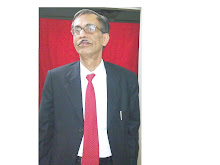It was the April Fools Day that I met Mr. Asa Singh, a very soft-spoken, rather reserved, yet smiling gentlemen, somewhat short by the Punjabi Sardarji standards, at his office. I was required to meet Mr. Singh, the Chief of Corporate Planning with my appointment letter. I liked him from the very first meeting and felt a feeling of affection flowing from him. We discussed about us, the work ahead and the responsibilities for a while, before he rang up the Chief of Personnel, who would soon send down an officer from his department to enable me to complete the documentation formalities related to my joining as the Econometrician of the Corporate Planning Department of Coal India Ltd., my new employer.
As per the organization chart, my code was C-3 (most departments were denoted by X followed bu a number like 1, 2, 3, etc: in the case of Corporate Planning the symbol was C and my division was 3 and therefore my code was C-3). Mr. Asa Singh told me that Coal India had already prepared a 10 year plan code named as Project Black Diamond. He gave me a copy of that document to read and re-read as much of our work in Corporate Planning would be centered around and related to updating, revising, elaborating, projecting, estimating, reviewing the various aspects covered in this document. He also said that C-1 and C-2 would join the Department to had the other two divisions of technology and finance (till the time I had been with Coal India, no X-1 or X-2 would join).
I was assigned a big room which was earlier used by the visiting consultants from the Administrative Staff College of India, Hyderabad. They would be visiting again and again from time to time and would be sitting and discussing with me. One of my tasks therefore was to coordinate the work of the Consultants and follow-up with the implementation of their reports. Eventually, I would happen to be transformed into an in-house consultant.
Soon we would be having a meeting with Mr RC Shekhar, Director Finance of the company and Mr. Asa Singh told me that I have to associate myself with the study on cost of mining coal under Mr. Shekhar supervision. We were about five/ six officers who would be associated with the study. Mr. Sengupta, a chartered accountant and third in command in the finance department was the team leader (Mr. Sengupta would after 25-18 years become the Chairman of Coal India): two of his colleagues, an elderly Cost Accountant and newly appointed MBA (Finance) from IIM Ahmedabad, Mr. Bhowmik would be in the team besides me.
Even as I was trying to settle down to this new environment and trying ti figure out how to productively spend the eight hours in the office, I received a shocking telephone call from the Chief of Staff one morning 20 days after I had joined that the Coal India Chairman has desired to interview me at 3 PM in the afternoon. I was not very clear why the Chairman would interview me after I have joined and not before. I was rather very uncomfortable when I entered his room that afternoon. I was with him for an hour. When I came out of the room I was filled with joy and enthusiasm: I got the impression that the Chairman rated me so high as an asset of the organization and how he has planned my utilization with care and affection. I was completely sold to him. We were three in his room. He, his Executive Secretary, Mr. Mathur, a mining engineer and I. The chairman just asked me questions about me, my family, my education, my previous work experience and so on.
Every answer that I gave to the Chairman's questions was received by him with appreciation, affection and encouragement. His Executive Secretary, Mr. Nagar, had already done some research on me and was telling the Chairman about some articles that were published in the previous one or two months in The Business Standard: he even showed the clippings of my article on Management Information System and Research in Banks. The only question my answer did not receive immediate positive reaction was that I hadn't earlier worked outside Calcutta. That day, I wished that I my next job takes me outside Kolkata: little that I could imagine that this would happen and I would land myself in Mumbai a few years later.
Chairman finally told me that he was instructing the Executive Secretary for my 7-day visit to each of Coal India's (then five) subsidiaries, the Easter Coalfields, the Bharat Coking Coal Ltd, the Central Coalfields Ltd, the Western Coalfield Ltd and the Central Mine Planning and Design Institute. The program of visit would be spread over 10 weeks and would cover besides each company headquarters and Area Managers' offices, six underground mines and 2 open cast mines.
When I came out of the Chairman's room, I felt that I have joined an organization that really values my worth and has real interest in utilizing my skills and potential. I understood for the first time that the army generals really knew how to win hearts of the people they would work with and keep their motivation and morale high. In a few months, I would learn more about managing people from Lt. General Grewal, the Coal India Chairman.
Monday, May 9, 2011
Subscribe to:
Posts (Atom)
